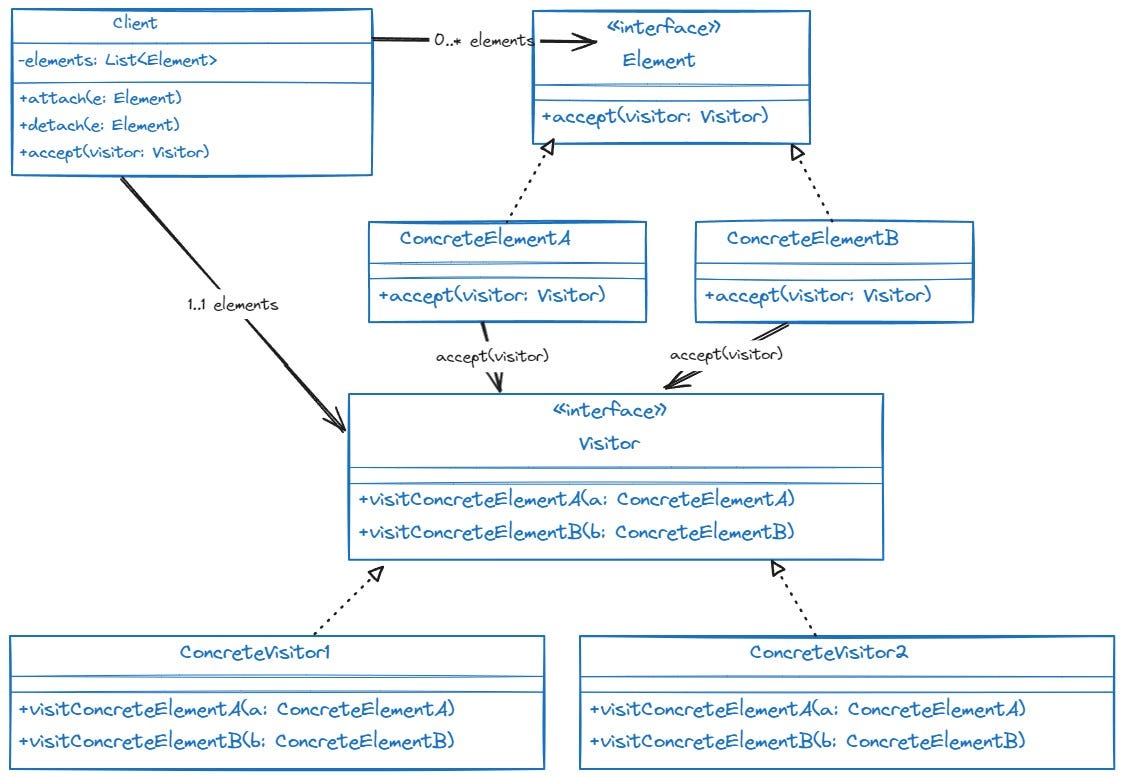Visitor Pattern in Java
Exploring the Visitor Pattern: A Deep Dive into Its Implementation and Applications in Java
The Visitor Pattern is a frequently used software design pattern that separates the algorithm from the object structure it operates on. This pattern enables you to add new operations to existing object structures without modifying their classes. By defining a visitor interface and implementing concrete visitors, you can perform various operations on objects in a type-safe manner. The Visitor Pattern enhances code maintainability, promotes separation of concerns, and allows for greater flexibility and extensibility in complex systems. In this article, as you know we will discover it, and understand why it is so frequently use and why it is so important.
What is the Visitor Pattern?
The Visitor Pattern is a behavioral design pattern that allows you to add further operations to objects without having to modify them. It separates an algorithm from the object structure on which it operates, allowing you to define new operations without changing the classes of the elements on which it operates.
In Java, the Visitor Pattern is typically used when you have a structure of objects, such as a composite object, and you want to perform operations on these objects that depend on their concrete classes.
Visitor Pattern Usage inside Frameworks and Tools
The Visitor Pattern is widely utilized in various Java frameworks and libraries to enable flexible and maintainable operations on complex object structures. Here are some notable examples:
Java Compiler API (javax.lang.model):
Usage: The Visitor Pattern is used in the Java Compiler API to traverse abstract syntax trees (ASTs).
Example: **ElementVisitor **and **TypeVisitor **interfaces allow you to define operations that can be performed on different types of elements and types, respectively, in the AST.
XML Processing (DOM API):
Usage: In the Document Object Model (DOM) API, the Visitor Pattern can be used to traverse and manipulate XML documents.
Example: Custom visitors can be implemented to navigate through nodes of an XML document and perform specific actions like validation, transformation, or extraction of information.
Spring Framework:
Usage: Spring’s BeanFactory and ApplicationContext make use of the Visitor Pattern internally to perform operations on bean definitions.
Example: During bean initialization, various visitors might be used to apply configuration metadata or post-processing logic to beans.
ANTLR (Another Tool for Language Recognition):
Usage: ANTLR, a powerful parser generator, uses the Visitor Pattern to traverse parse trees generated from source code.
Example: The **ParseTreeVisitor **interface allows the implementation of visitors that can perform semantic analysis, optimization, or code generation based on the parse tree structure.
Hibernate:
Usage: Hibernate ORM uses the Visitor Pattern for traversing and processing the entity graph.
Example: Visitors are used to implement various operations such as dirty checking, cascade operations, and fetching strategies.
Apache POI:
Usage: Apache POI, a library for manipulating Microsoft Office documents, uses the Visitor Pattern to process different parts of documents.
Example: The **HSSFVisitor **can be used to navigate through Excel files to read, write, or transform data.
- Jackson JSON Processor:
Usage: Jackson, a popular JSON processing library, uses the Visitor Pattern to traverse and process JSON trees.
Example: The **JsonNodeVisitor **interface can be implemented to perform operations like serialization, deserialization, and data transformation on JSON node structures.
By leveraging the Visitor Pattern, these frameworks and libraries can cleanly separate operations from the object structures they manipulate, allowing for more maintainable and extensible code.
Structure of the Visitor Pattern
Visitor Interface: Declares a visit method for each type of concrete element.
Concrete Visitor: Implements the visitor interface and defines the actions to be performed on each type of element.
Element Interface: Declares an accept method that takes a visitor as an argument.
Concrete Element: Implements the element interface and the accept method, calling the appropriate visit method of the visitor.
Object Structure: Typically a collection of elements that can be iterated over.
Here’s a simple example to illustrate the Visitor Pattern in Java:
1
2
3
4
5
6
7
8
9
10
11
12
13
14
15
16
17
18
19
20
21
22
23
24
25
26
27
28
29
30
31
32
33
34
35
36
37
38
39
40
41
42
43
44
45
46
47
48
49
50
51
52
53
54
55
56
57
58
59
60
61
62
63
64
65
66
67
68
69
70
71
72
73
74
75
76
77
78
79
80
81
82
83
84
85
86
87
88
89
90
91
92
// Visitor interface
interface Visitor {
void visit(Book book);
void visit(Fruit fruit);
}
// Concrete Visitor
class ShoppingCartVisitor implements Visitor {
@Override
public void visit(Book book) {
System.out.println("Book: " + book.getTitle() + ", Price: " + book.getPrice());
}
@Override
public void visit(Fruit fruit) {
System.out.println("Fruit: " + fruit.getName() + ", Weight: " + fruit.getWeight() + ", Price: " + fruit.getPrice());
}
}
// Element interface
interface ItemElement {
void accept(Visitor visitor);
}
// Concrete Element - Book
class Book implements ItemElement {
private String title;
private double price;
public Book(String title, double price) {
this.title = title;
this.price = price;
}
public String getTitle() {
return title;
}
public double getPrice() {
return price;
}
@Override
public void accept(Visitor visitor) {
visitor.visit(this);
}
}
// Concrete Element - Fruit
class Fruit implements ItemElement {
private String name;
private double weight;
private double price;
public Fruit(String name, double weight, double price) {
this.name = name;
this.weight = weight;
this.price = price;
}
public String getName() {
return name;
}
public double getWeight() {
return weight;
}
public double getPrice() {
return price;
}
@Override
public void accept(Visitor visitor) {
visitor.visit(this);
}
}
// Client
public class VisitorPatternDemo {
public static void main(String[] args) {
ItemElement[] items = new ItemElement[]{
new Book("Design Patterns", 30.00),
new Fruit("Apple", 2.0, 3.00)
};
Visitor visitor = new ShoppingCartVisitor();
for (ItemElement item : items) {
item.accept(visitor);
}
}
}
Motivation for Using the Visitor Pattern
Separation of Concerns: The Visitor Pattern promotes the separation of concerns by separating the algorithm from the object structure it operates on. This makes the system more modular and easier to understand.
Extensibility: It allows you to define new operations without changing the classes of the elements on which it operates. This makes it easy to add new functionality as the system evolves without modifying existing code.
Improved Maintainability: By using the Visitor Pattern, you can centralize related behavior in a visitor rather than scattering it across the object structure. This reduces code duplication and improves maintainability.
Enhanced Flexibility: It provides a way to define a new operation without changing the classes of the elements on which it operates, which is particularly useful when dealing with a complex object structure.
Decoupling: It decouples the operations from the object structure, making it easier to change the object structure without impacting the operations, or vice versa.
Understanding and using the Visitor Pattern can lead to cleaner, more maintainable, and more flexible code, especially when dealing with complex object structures that require a variety of operations.
Visitor Pattern usecases
The Visitor Pattern is particularly well-suited for scenarios where you need to perform multiple operations on a complex object structure. Here are some common and perfect use cases for the Visitor Pattern:
1. Compilers and Interpreters
Use Case: Traversing Abstract Syntax Trees (ASTs)
Description: Compilers and interpreters often need to perform various operations on ASTs, such as semantic analysis, optimization, and code generation.
Example: Implementing visitors that can traverse the AST to check for type correctness, perform optimizations, or generate bytecode.
2. Document Processing
Use Case: Manipulating XML or JSON documents
Description: When working with hierarchical document structures like XML or JSON, different operations like validation, transformation, or extraction need to be applied to various elements or nodes.
Example: Using visitors to navigate through an XML DOM tree to apply XSL transformations or validate against a schema.
3. GUI Component Frameworks
Use Case: Operating on complex UI component hierarchies
Description: GUI applications often have complex component trees, and operations like rendering, event handling, and layout management need to be applied consistently across the hierarchy.
Example: Implementing a visitor to apply specific rendering logic to different types of UI components (e.g., buttons, panels, text fields).
4. File Systems
Use Case: Traversing directory structures
Description: File systems are hierarchical in nature, and operations such as searching, compressing, or copying files and directories can benefit from a consistent traversal approach.
Example: Using visitors to search for files matching certain criteria, compress directories, or calculate directory sizes.
5. Graph Algorithms
Use Case: Applying algorithms to graph data structures
Description: Graphs, which can represent networks, dependencies, or relationships, require various algorithms for traversal, searching, and processing.
Example: Implementing visitors for depth-first search (DFS), breadth-first search (BFS), or finding shortest paths in a graph.
6. Software Metrics
Use Case: Collecting metrics from source code
Description: Analyzing source code to gather metrics such as cyclomatic complexity, line count, or dependency analysis requires traversing code structures.
Example: Using visitors to walk through the code’s abstract syntax tree (AST) to collect and calculate various software metrics.
7. Financial Systems
Use Case: Processing different financial instruments
Description: Financial applications often need to perform operations on various financial instruments like stocks, bonds, and derivatives, each requiring specific processing logic.
Example: Implementing visitors to apply pricing algorithms, risk assessment, or regulatory compliance checks on different financial instruments.
8. Testing and Mocking
Use Case: Generating test cases or mocks
Description: In automated testing, it might be necessary to generate test cases or mocks by traversing data structures representing test scenarios or system states.
Example: Using visitors to create mock objects or test data based on the structure of the application’s data model.
9. Entity-Relationship Models
Use Case: Database schema operations
Description: Operations like schema migration, validation, or documentation generation can be applied to the various components of an entity-relationship model.
Example: Implementing visitors to validate schema constraints, generate migration scripts, or create documentation based on the ER model.
10. Game Development
Use Case: Applying game logic to entities
Description: In games, entities like players, enemies, and obstacles need different behaviors applied, such as movement, collision detection, and rendering.
Example: Using visitors to implement specific game logic that can be applied to various game entities during each frame of the game loop.
The Visitor Pattern shines in these use cases by providing a clean way to separate the operations from the object structures, thereby enhancing code maintainability, flexibility, and extensibility.
Conclusion
The Visitor Pattern is a powerful design pattern that separates operations from the objects on which they operate, providing a flexible and maintainable approach to adding new functionality to complex object structures. By leveraging the Visitor Pattern, you can cleanly define operations that can be applied to various elements of an object structure without modifying their classes. This promotes separation of concerns, enhances extensibility, and simplifies the maintenance of codebases, particularly in scenarios involving compilers, document processing, GUI frameworks, file systems, and more.
Understanding and implementing the Visitor Pattern is essential for software developers working with hierarchical or composite object structures, as it allows for the consistent application of algorithms and operations while keeping the codebase modular and adaptable to future changes. Through its use in many Java frameworks and libraries, the Visitor Pattern demonstrates its practicality and effectiveness in real-world applications, making it a valuable tool in the developer’s toolkit.
Full example you can find on Github.

